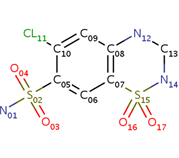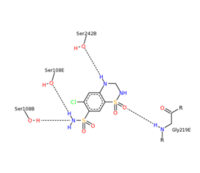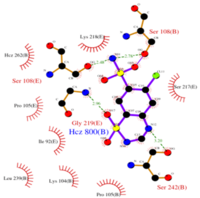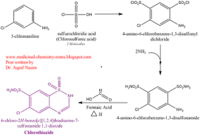Sandbox1996
From Proteopedia
(Difference between revisions)
| Line 23: | Line 23: | ||
===Hypertension=== | ===Hypertension=== | ||
| - | Although Diuril was introduced as an anti-diuretic drug, its antihypertensive properties were discovered when two researchers from Boston and Washington D.C administered the drug to patients suffering from congestive heart failure, edema and severe hypertension, and noted a dramatic reduction in high blood pressure. Unlike other hypotensive drugs that lower blood pressure equally in both hypertensive and normotensive patients, Diuril reduces the blood pressure of patients in the hypertensive state only. It, therefore, possesses considerable specificity. Diuril was also favored over other hypotensive drugs due to ease in its administration; it was delivered orally and required no hospitalization, | + | Although Diuril was introduced as an anti-diuretic drug, its antihypertensive properties were discovered when two researchers from Boston and Washington D.C administered the drug to patients suffering from congestive heart failure, edema and severe hypertension, and noted a dramatic reduction in high blood pressure. Unlike other hypotensive drugs that lower blood pressure equally in both hypertensive and normotensive patients, Diuril reduces the blood pressure of patients in the hypertensive state only. It, therefore, possesses considerable specificity. Diuril was also favored over other hypotensive drugs due to ease in its administration; it was delivered orally and required no hospitalization, or testing to monitor immediate adverse effects. When combined with agents such as ganglionic blockers, reserpine, and hydralazine, the drug's efficacy was synergistically increased while its respective toxicities were minimized <ref name = "four"> Greene, J.A. (2005) Releasing the flood waters: diuril and the reshaping of hypertension, Bull. Hist. Med. 79, 749-794. </ref>. |
===Decrease Edema=== | ===Decrease Edema=== | ||
| Line 31: | Line 31: | ||
===Diabetes Insipidus=== | ===Diabetes Insipidus=== | ||
| - | Diabetes insipidus | + | Diabetes insipidus is a rare disorder in which an individual excretes a large amount of dilute and odorless urine. There are four different types of diabetes insipidus; central, nephrogenic, dipsogenic and gestational. High concentrations of sodium and potassium are characteristic of all types of diabetes insipidus. Treatment with Diuril demonstrates a decrease in saluresis, the excretion of sodium and chloride, within approximately eight hours following the initial dose, and a decrease in kaliuresis, the excretion of potassium ions, approximately fifteen hours following the initial dose <ref name = "seven"> Crawford, J.D., Kennedy, G.C., and Hill, L.E. (1960) Clinical results of treatment of diabetes insipidus with drugs of the chlorothiazide series, N. Engl. J. Med. 262, 737-743. </ref>. |
===Kidney Stones=== | ===Kidney Stones=== | ||
| Line 38: | Line 38: | ||
===Side Effects=== | ===Side Effects=== | ||
| - | One main side effect that should be noted when taking Diuril is the introduction of | + | One main side effect that should be noted when taking Diuril is the introduction of purpura, or excessive bruising and superficial bleeding, typically on the legs <ref name = "eight"> The Mayo Clinic Staff. (2017) Idiopathic thrombocytopenic purpura (ITP), Mayo Clinic. Retrieved from http://www.mayoclinic.org/diseases-conditions/idiopathic-thrombocytopenic-purpura/symptoms-causes/dxc-20201224 </ref>. There are many different types of purpura, but the general bleeding of small vessels and inflammation hold true. Some patients, when taking Diuril more regularly, as in twice a day for a specific number of weeks, will exhibit purpura. This can be treated typically with bedrest, minor medications, and discontinued use of chlorothiazide. One study from the Mayo Clinic showed that, after discontinuing use of chlorothiazide and then readministering a single dose, purpura reappeared quite rapidly, leading to inferences that chlorothiazide use was what originally brought on the purpura <ref name = "nine"> Jaffe, M.O. and Kierland, R. R. (1958) purpura due to chlorothiazide (Diuril), J. Am. Med. Assoc. 168, 2264-2265. </ref>. |
Revision as of 21:57, 18 April 2017
Diuril (Chlorothiazide)
| |||||||||||
References
- ↑ 1.0 1.1 The Metabolomics Innovation Centre. (2016) Chlorothiazide, DrugBank. Retrieved from https://www.drugbank.ca/drugs/DB00880
- ↑ Greene, J.A. (2005) Releasing the flood waters: diuril and the reshaping of hypertension, Bull. Hist. Med. 79, 749-794.
- ↑ 3.0 3.1 Drug.com. (2017) Diuril, Drugs.com. Retrieved from https://www.drugs.com/pro/diuril.html
- ↑ RxList Inc. (2017) Medical definition of diuretic, RxList: The Internet Drug Index. Retrieved from http://www.rxlist.com/script/main/art.asp?articlekey=7103
- ↑ Crawford, J.D., Kennedy, G.C., and Hill, L.E. (1960) Clinical results of treatment of diabetes insipidus with drugs of the chlorothiazide series, N. Engl. J. Med. 262, 737-743.
- ↑ 6.0 6.1 Simon, H. and Zieve, D. (2012) Kidney stones, University of Maryland Medical Center. Retrieved from http://umm.edu/health/medical/reports/articles/kidney-stones
- ↑ AHFS Patient Medication Information. (2017) Chlorothiazide, U.S. National Library of Medicine. Retrieved from https://medlineplus.gov/druginfo/meds/a682341.html
- ↑ The Mayo Clinic Staff. (2017) Idiopathic thrombocytopenic purpura (ITP), Mayo Clinic. Retrieved from http://www.mayoclinic.org/diseases-conditions/idiopathic-thrombocytopenic-purpura/symptoms-causes/dxc-20201224
- ↑ Jaffe, M.O. and Kierland, R. R. (1958) purpura due to chlorothiazide (Diuril), J. Am. Med. Assoc. 168, 2264-2265.




